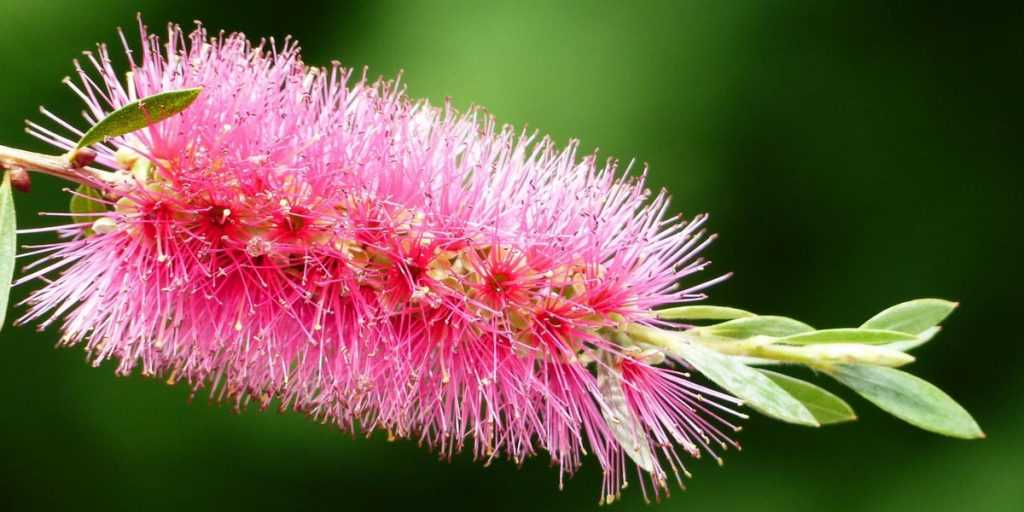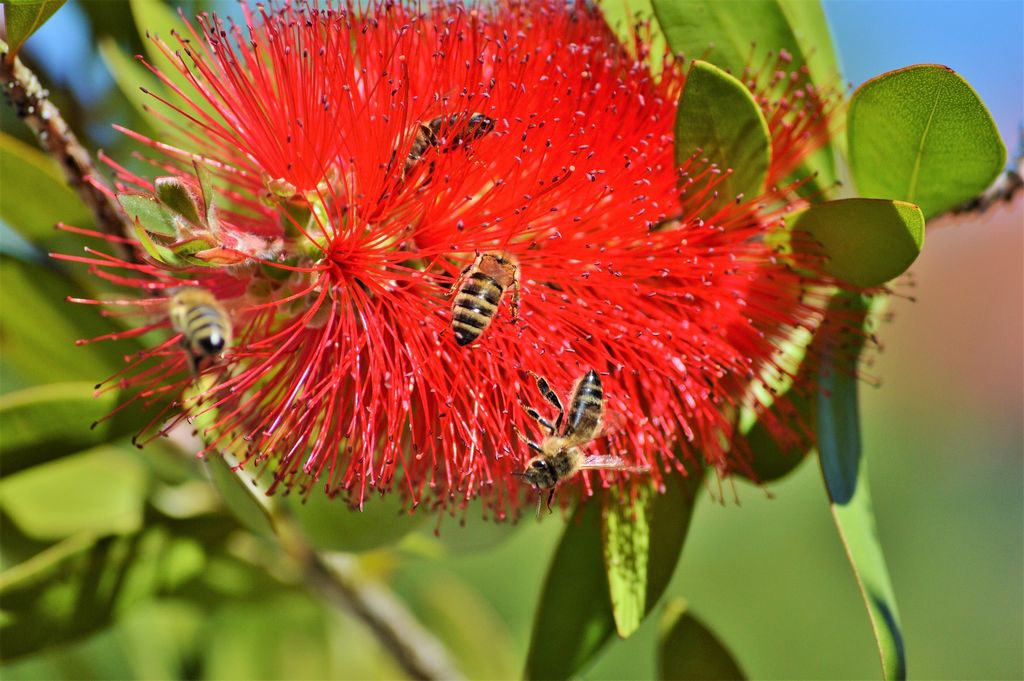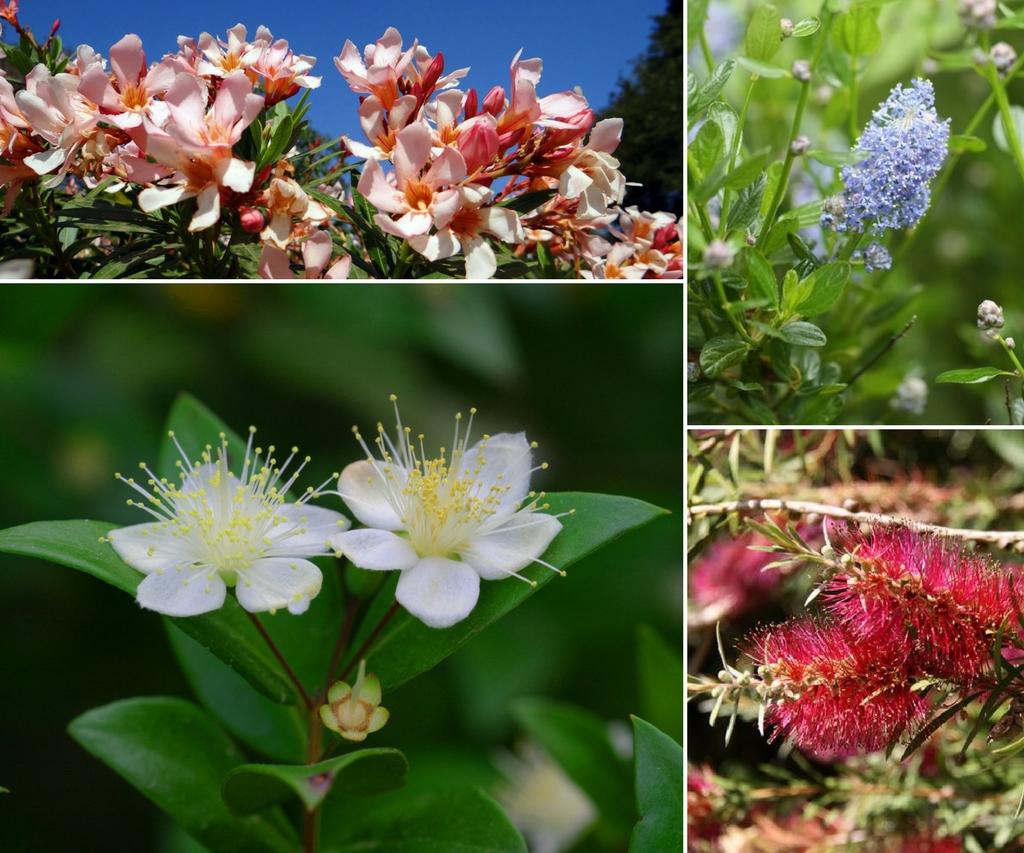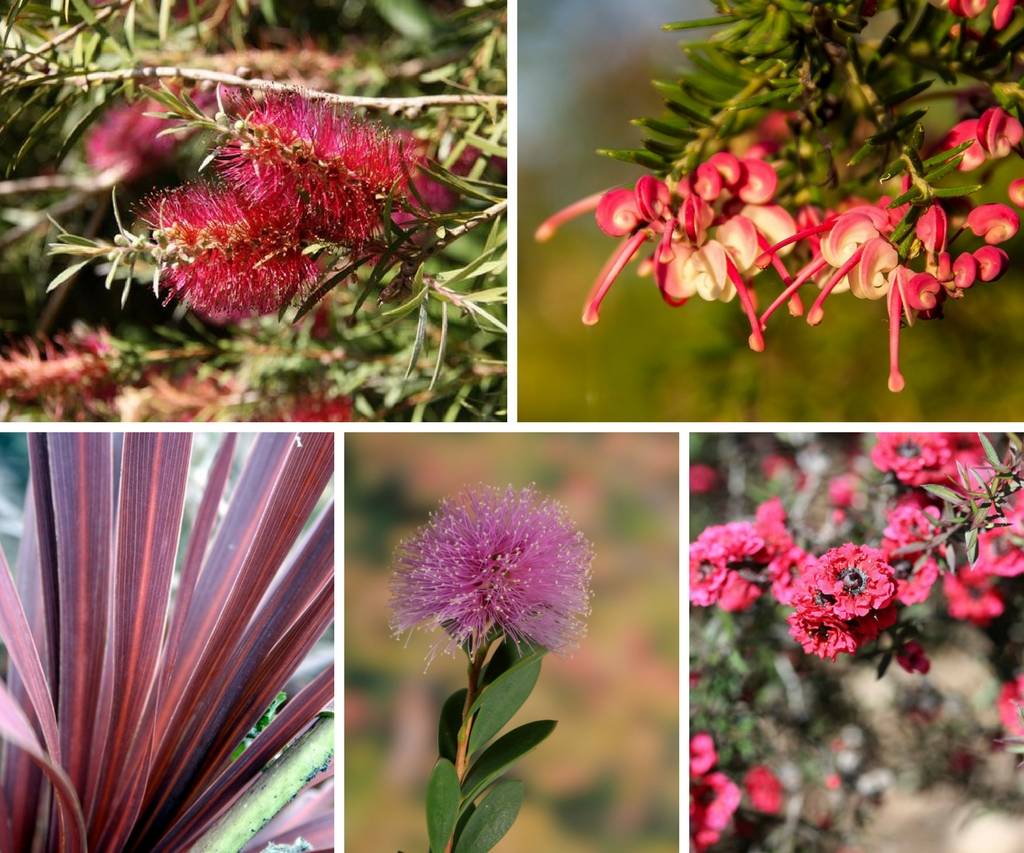
Callistemon, Bottlebrush: planting, pruning, care
Contents
Callistemon in a nutshell
- Callistemon, or ‘bottlebrush’, offers distinctive summer flowering in the form of bottlebrushes,
- It is an Australian evergreen bush with a bushy habit
- Tender but heat-tolerant, it prefers regions with a mild climate
- It grows in full sun in any well-drained soil
- In colder regions, it grows very well in pots
A word from our expert
Callistemon, also called ‘bottlebrush’ is a small Australian bush hardy to at least -8°C in perfectly drained soil; it tolerates occasionally dry, poor soil very well.
From spring to autumn and sometimes throughout the year depending on region, it forms a beautiful bush, covered with fine evergreen foliage, sometimes aromatic, where a profusion of flowers resembling small bottlebrushes blooms.

Callistemon owes its nickname “bottlebrush” to the typical shape of its flowers
If the most cultivated is Callistemon citrinus, there are species equally interesting such as Callistemon laevis with fiery red bottlebrushes, Callistemon rigidus, Callistemon viminalis with a beautiful fountain habit. Sensitivity to frost varies between species. It thrives in sun, tolerates sea spray and drought in summer. Its cultivation method varies according to region.
Garden cultivation is best reserved for mild climates, oceanic or Mediterranean. Elsewhere, it adapts perfectly to being grown in pots and overwintered like orangerie plants.
Its original, slightly lanky silhouette and its dazzling flowering make it indispensable in informal hedges or shrub borders of evergreen bushes.
How to prune a bottlebrush Callistemon, how to take a cutting? Discover all answers from our experts and let yourself be seduced by our collection of bottlebrushes to suit every budget.
Botany
Botanical data
- Latin name Callistemon
- Family Myrtaceae
- Common name Callistemon, Bottlebrush, bottlebrush plant
- Flowering from April–May until autumn
- Height 1 to 10 m
- Sun exposure Sun, partial shade
- Soil type Neutral, acidic, well drained
- Hardiness -5°C to -10°C
Genus Callistemon comprises about thirty species of trees and bushes with evergreen foliage, native to moist soils near waterways in temperate regions of Australia. The Callistemon commonly known as the “bottlebrush” or “bottlebrush plant” belongs to the family Myrtaceae alongside its relatives eucalyptus, myrtle and Leptospermum. It is sometimes confused with Melaleuca, with which it bears a striking resemblance.
Callistemon citrinus, Callistemon rigidus, and the very floriferous Callistemon viminalis and Callistemon laevis are the most common in gardens with mild winters. They have produced many cultivars more resistant to cold. Growth is quite fast if not checked by frost. Plants can live for many years.
It develops into an attractive bush with a neat, bushy habit in youth, sometimes remaining under 1 m tall, but it can also become a small tree reaching up to 10 m, with stems that may be slightly arched or very trailing.
The habit varies according to species and variety: rounded, semi-weeping over time, somewhat stiff in Callistemon rigidus, softening into a fountain-like habit in Callistemon viminalis, also called the weeping bottlebrush. It has a handsome reddish-brown or grey-brown bark in fissured strips, decorative in some species.
Evergreen, leathery foliage is attractive year-round. Leaves are long and narrow, 2–15 cm, alternate, elongated and pointed, sometimes so tapered they resemble needles. Leaves are rather sparse on Callistemon rigidus. Juvenile leaves have a silky, pubescent aspect and emerge in spring as young shoots tinged purple, grey-orange or salmon-red at bud burst period, later becoming glabrous, light green, bright green, acid green, grey-green to dark green. On Callistemon citrinus, aromatic leaves release an eucalyptus-and-lemon scent when crushed.
Callistemon is prized for its strikingly original summer flowering, in the form of colourful bottlebrushes that gave it its vernacular name. From May–June, for about a month and then more sporadically in autumn, small five-petalled flowers gathered into cylindrical spikes borne on a slender stem at the tip of young shoots appear.
They bear very long stamens beautifully dusted with golden-yellow pollen, making them look like cleaning brushes. Spikes are topped by a tuft of young shoots. Flower colour and habit vary by species.

Development of a Callistemon flower
Covering the whole bush, these upright or slightly drooping inflorescences can measure up to 15 cm long and give the plant a pendulous or, conversely, bristly appearance.
These feathery floral spikes, most often bright red and sometimes almost fluorescent, also occur in softer shades from pure white to cream (Callistemon citrinus ‘White Anzac’), through purplish-pink (Callistemon viminalis ‘Hot Pink’), mauve (Callistemon ‘Violaceus’) or even lemon yellow (Callistemon pityoides). Flowers of Callistemon citrinus give off a delightfully lemony scent.
Flowering occurs in successive waves and can reoccur up to four times a year, from June to August–September depending on climate: the terminal bud repeatedly produces new leaves, then new bottlebrushes, particularly at the end of summer.
Melliferous and nectariferous, the flowers attract many pollinating insects such as bees and butterflies.

Callistemon is much appreciated by bees.
Spent spikes produce small fruits 4–6 mm long in the form of spherical capsules, half embedded in the twig bark. These very hard little shells contain brown seeds as fine as dust. Callistemon is a pyrophilous species; passage of fire causes fruits to burst and promotes release of seeds in dormancy.
Callistemon is a rather tender plant, hardy down to about -5°C/-8°C, sometimes to -12°C in well-drained soil, for the less frost-sensitive varieties. It is, however, easy to grow in regions with mild winters. In the ground, reserve it for Mediterranean or Atlantic climates where it can be used as a specimen plant or in an informal hedge. In cold climates, grow in a container and keep as a conservatory plant.
It thrives in sun or partial shade in fertile, light, well-drained soil, remaining moist to dry in summer.
Read also
Plant and grow southern plantsSpecies and main varieties
Genus comprises mostly species of medium hardiness (-10°/-12°C) to low (-5°/-8°C) for Callistemons most sensitive to frost. While most widespread and the first “bottlebrush” cultivated in our gardens long remained Callistemon citrinus, then Callistemon rigidus, doubtless due to their greater resistance to frost (-12°C in perfectly well-drained soil), the very floriferous Callistemon viminalis and Callistemon laevis, of lesser hardiness, have also found a place at our latitudes. Today there are numerous cultivars more resistant to cold as well as compact varieties well suited to container culture.

Callistemon citrinus Splendens - Bottlebrush
- Flowering time July to September
- Height at maturity 2,50 m

Callistemon rigidus - Bottlebrush
- Flowering time June, July
- Height at maturity 2,50 m

Callistemon viminalis - Bottlebrush
- Flowering time June to October
- Height at maturity 7 m

Callistemon viminalis Hot Pink - Bottlebrush
- Flowering time June to October
- Height at maturity 1,50 m

Callistemon laevis - Bottlebrush
- Flowering time June to October
- Height at maturity 1,80 m
Discover other Callistemon
View all →Available in 2 sizes
Available in 1 sizes
Available in 2 sizes
Available in 1 sizes
Available in 1 sizes
Available in 2 sizes
Available in 2 sizes
Available in 2 sizes
Available in 1 sizes
Available in 2 sizes
Planting
Where to plant a bottlebrush
Callistemon is grown differently depending on region. Generally fairly tender, it is hardy to frosts of around -8°C but aerial parts can be damaged by cold from about -5°C. Hardier species such as Callistemon citrinus can withstand temperatures of around -10 to -12°C for short periods.
Cultivation in open ground should be reserved for regions where winters remain mild and where frost is not prolonged. You can plant it outdoors without problem south of the Loire. Resistant to wind and sea spray, it is also a good plant for coastal gardens.
In regions where frosts are frequent but short and light, site it on a south-facing aspect sheltered against a wall.
In open ground, it thrives in sun, protected from prevailing winds to preserve its rather brittle stems, especially when they bend under the weight of the flowers. It will also tolerate partial shade, where it will nevertheless be less floriferous.
It adapts to almost any soil, fresh or dry in summer. It grows in non-calcareous soil, fairly fertile. In deep soil, once well established, it will show increased drought resistance. A slightly stony or sandy soil, slightly acidic to neutral, provided it is well drained, will suit it equally well. Some species (Callistemon pallidus), native to marshy coastal fringes of Australia, tolerate temporary flooding and poor drainage.
Although able to grow in poor, relatively dry soil, Callistemon prefers soils that remain cool in summer and greatly appreciates watering in dry climates.
Allow enough space: fast-growing, it will quickly form a large bush, sometimes exceeding 6 m in height and nearly as much in width. Some species such as the weeping Callistemon can reach 8 to 10 metres in height at our latitudes.
In harsher climates, north of the Loire, prefer planting in a large container to be put away for winter in an unheated greenhouse or conservatory. Ensure good drainage and water abundantly, allowing the substrate to dry out between waterings.
In a pot as in open ground, Callistemon brings striking interest to gardens and terraces. It can be placed in centre or background of a mixed border, as a specimen or as a loose or evergreen hedge.
When to plant Callistemon
Planting of Callistemon is best done in April–May once all risk of frost has passed, or in early autumn in very mild climates.
How to plant a Callistemon
Planting a Callistemon is easy to succeed. If your soil tends to be calcareous, add a mix of heather soil and compost to garden soil. Callistemon appreciates having roots kept cool in summer and must never show signs of dehydration: watering must therefore be abundant and regular throughout the warm season — if Callistemon leaves dry out, it will not recover.
In open ground
- Dig a hole 3 to 5 times wider than the rootball
- Make a good bed of gravel at bottom of hole
- Plant the bush at collar level in centre of hole in a mix of compost, potting compost, ground bone meal, coarse sand and garden soil
- Fill the hole while keeping the bush upright
- Firm the soil with your foot
- Mulch around base of plant
- Water thoroughly at planting then once or twice a week throughout the warm season, especially during first summers
- Reduce waterings in autumn and stop them in winter
In a pot
Good drainage is essential. It will also have increased water requirements but take care with excesses that would yellow its foliage!
- In a pot of at least 50 cm diameter, spread a good layer of drainage (gravel or clay balls) at the bottom
- Plant in a slightly sandy substrate, enriched with leaf mould, and mulch the base
- In summer, water generously as soon as the soil is dry, about twice a week
- In winter, water very sparingly
- Apply a slow-release fertiliser in spring
- Bring pot indoors to shelter from frost at first cold spells in colder regions
As soon as risk of frost has passed, move Callistemon out into garden so it can enjoy warm season.
Care and maintenance
Callistemon is easy to grow in Mediterranean regions or Atlantic coastal areas with mild winters.
Once well established, it requires little attention and will become increasingly resistant to drought. Bottlebrushes grown in pots require more maintenance than callistemons in open ground.
Callistemon likes cool soil in summer. During warm season, water abundantly and regularly once or twice a week to keep roots cool but above all not waterlogged. Space out watering frequency in autumn and stop watering in winter.
It likes roots cool in summer and warm during cold season. Mulch base of bush in autumn to protect it from frost, especially during first winters. In case of severe frosts forecast, protect aerial parts with a winter fleece and, in cold climates, follow our advice : Callistemon, Bottlebrush: how to protect it from the cold in winter?
In pot
Water regularly throughout summer. During growth, to encourage flowering, apply a good slow-release fertiliser once or twice a year. Bring it into a cool greenhouse for winter where temperature does not fall below 7 °C. Continue to water about once a month. Replace potting compost after 4-5 years, do so after flowering.
When and how to prune a bottlebrush?
Callistemon must imperatively be pruned just after flowering to keep a bushy habit. Pruning stimulates flowering, regrowth of branches and also helps maintain a compact, attractive habit. Pruning also prevents fruiting that could exhaust the plant.
- Prune at end of flowering or in late autumn to correct habit
- Maintenance simply involves removing in late winter weak shoots, dead wood and branches broken by wind
- To encourage repeat flowering: remove faded flowerheads as they fade
- If you want to reduce its growth to preserve a compact habit, it will tolerate an occasional hard prune
Diseases and potential pests
Callistemon is not very susceptible to pests and is fairly disease-resistant, however, plants grown under glass can be more susceptible to parasitic infestations.
In case of an invasion of red spider mites, spray with soapy water.
It can also be attacked by scale insects. Treat with sprays of rapeseed oil. Repeat two or three times at 15-day intervals.
Sawfly larvae or false caterpillars can literally devour the leaves like voracious leaf-cutters! A solution of black soap may be enough to get rid of them.
Cylindrocladium scoparium, a fungus naturally present in Myrtaceae, can cause spots on foliage and stem necrosis.
In overly calcareous soil or with excess water, leaves turn yellow from chlorosis. Good drainage and regular additions of compost and heather soil by forking in at the base of the bush can sometimes prevent it.
→ Learn more about diseases and parasitic organisms of Callistemon in our care sheet
Multiplication
Propagation of Callistemon by sowing seeds is possible (provided seed capsules are warmed first over a candle flame!) but flowering will occur only 3 to 6 years later. Semi-ripe cuttings taken at the end of summer are easier and more reliable. Rooting can be slow but flowering takes place from the first year.
- At the end of summer, take semi-ripe shoots of 10 to 15 cm, cutting just below an eye (i.e. shoots in transition from soft wood to hard wood)
- Make a 5 cm lengthwise notch in the bark
- Remove leaves from lower third
- Plant them in a light, free-draining mix of sand and potting compost
- Keep growing medium moist until rooting, which can take several months
- Pot up cuttings the following spring or plant out permanently
- Water well during first year after planting
→ Learn more in our tutorial: Propagate a Callistemon
Associate
Particularly remarkable for the luminous or incandescent burst it offers throughout summer, Callistemon or “bottlebrush” thrives in all natural, wild gardens. On the Mediterranean coast or in an Atlantic climate, it can be planted almost anywhere in the garden: as a specimen, at the back of a perennial bed, or grouped in informal hedges. It creates lush, generous summer scenes.
It will be sensational in an evergreen hedge, alongside a shrubby ceanothus (‘Skylark’), a summer-flowering broom (Cytisus scoparius ‘Apricot Gem’), together with myrtles or oleanders.

An example of a planting in an evergreen hedge: Nerium oleander – Ceanothus ‘Skylark’ – Myrtus communis – Callistemon viminalis
In an informal hedge, it pairs easily with Caesalpinia gillesii or with buddleias. With its distinctive silhouette, it is a good partner for tamarisks, hibiscus and smoke trees.
It tolerates sea spray well, making it a very fine bush for mixed hedges in coastal gardens.
As a specimen in the centre of a bed of low or groundcover plants or in a large rockery, it will be magnificent surrounded by full-sun perennials such as small cistus, Linaria purpurea, oriental poppies, echinaceas, coreopsis and rudbeckias that will set off its spectacular flowering.
You can plant its base with shrubby perennials that flower in summer, such as Salvia with red flowers.
Create an evergreen bed with garrigue accents using lavenders, prostrate rosemary and euphorbias to accompany it.
In a more exotic-style bed, pair it with its Australian cousins such as Phormium, Melaleuca gibbosa, Grevillea rosmarinifolia and Leptospermum.

An example of an exotic planting: Callistemon viminalis – Grevillea rosmarinifolia – Phormium – Melaleuca gibbosa and Leptospermum scoparium ‘Red Damask’.
In a greenhouse or conservatory, it partners well with an orange tree or mimosa.
→ Discover more pairing ideas with Callistemon in our advice sheet!
Useful resources
- From classic to exclusive varieties, discover our collection of bottlebrush
- Advice sheet: How to prune Callistemon?
- Advice sheet: Callistemon or Bottlebrush: best varieties
- Advice sheet: Callistemon, Bottlebrush: how to protect it from cold in winter?
- Advice sheet: How to choose a Callistemon?
Frequently asked questions
-
Why isn't my Callistemon flowering?
From its southern origins, Callistemon has retained a love of full sun. It refuses to flower in dense shade; its aspect may not be sunny enough. This bush flowers in late spring and then sometimes sporadically for the rest of the year. Finally, the "bottlebrush" is more floriferous in soil that is not too dry and without excess lime. Water regularly throughout the warm period. By removing faded flowers as they appear, you will also encourage further flowering.
-
My bottlebrush's leaves are dry after winter — should I be worried?
If all leaves and small branches are dry, it has probably been hit by a cold snap and frozen. It is nonetheless fairly hardy and should regrow from the stump. It is a Mediterranean plant and rather frost-tender. Cultivation in open ground will only really be suitable in regions where winters remain mild and temperatures do not fall below -8°C for a short period.
- Subscribe!
- Contents








































Comments